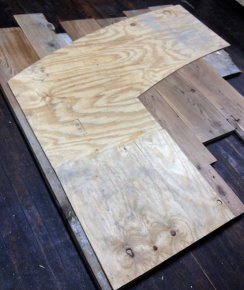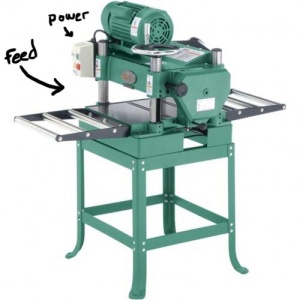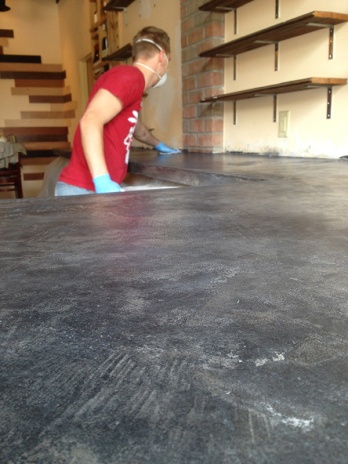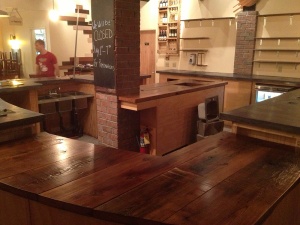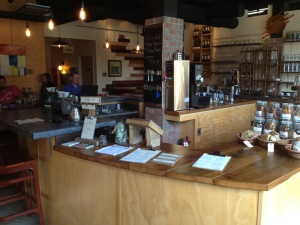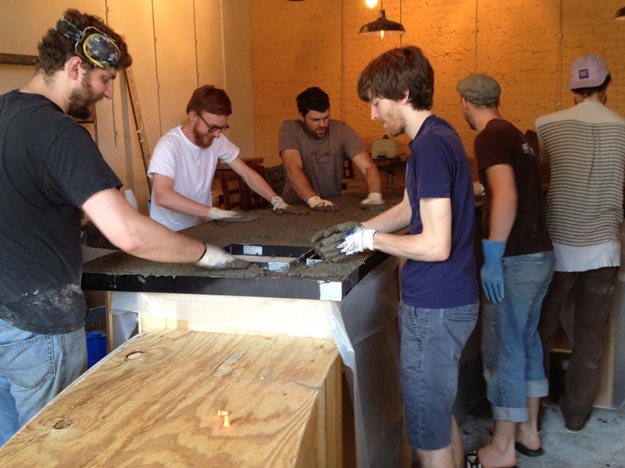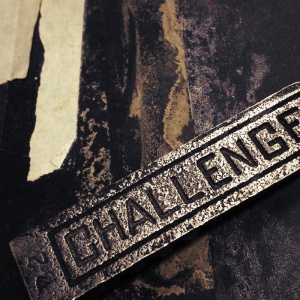I can hear you now. You’re saying, “This toppelduskin thing sounds intriguing, Mike. I really want to make one. But I’m a little embarrassed to ask: What is a toppelduskin?”
Haha! Don’t be the least bit embarrassed. I only encountered my first officially recorded toppelduskin—quite by accident—just a couple of short years ago.
It happened like this.
So, I’m doing crafts with the kids in our congregation. And we are making—well, I don’t quite remember—but it did involve using seeds from various plants. And I had brought along an avocado seed because I have always thought they were cool, and I wanted to show the kids a bit of the amazing diversity of seeds types. (For some odd reason, I have an affinity for avocado seeds. I have a hard time throwing them away. They just seem so substantial and weighty—filled with untold possibilities.) At any rate, I had no intention that any of them would try to use the mammoth pit in their little creations. I was shortsighted.
All the kids were engrossed in making their seed-encrusted creations. And I looked over at Chuck, one of a pair of twin boys. He had seized upon the avocado pit and had pressed it into a blob of Play-doh. He was in the process of placing another hunk of dough on top of it. Intrigued, I asked Chuck what he was making. Without hesitation, he replied:
“I’m making a toppelduskin.”
I was shocked. What appeared to my untrained eye to be simply a random heap of stuff, was actually the product of clear a vision
“A toppelduskin?” I said. “I’ve never heard of that before! What’s that?”
His twin brother, Dave, with that uncanny insight that only twins have of their counterparts, immediately responded: “he just made that up”.
I was doubly impressed. Not only had this bright boy invented a new word on the spot, but his twin was so attuned to his brother that he instantly recognized it as a freshly minted word.
Wait. I was TRIPLY impressed. I had just witnessed the birth of an honest-to-goodness new word. Not one of those modern, so-called new words that are simply the mashing together of two common words like “blogosphere” of “thingiverse”. No. This was a spontaneous amalgamation of sounds that could only flow from the free mind of a child. A mind unfettered by grammatical rules and grownup-imposed notions about what is—and what is not—a “real” word.
It was a magical moment.
Ever since that glorious and fateful day, I have added toppelduskin to my arsenal of useful, important and fun words. And, I have gradually come to understand that a toppelduskin is not always an avocado pit pressed into Play-doh, but can indeed be any thing-that-you-make-that-you-don’t-know-what-it-is. And so, I am on a crusade to encourage others to make and/or identify toppelduskins wherever they might find them.
I have stumbled across the occasional, unintentional toppelduskin on Etsy, although none of the crafters are yet aware of the word. One shining example that comes to mind is the one I found while looking for uses for discarded ceramic power line insulators. I had recently acquired a small batch from the roadside. They looked pretty cool, so I bundled them into my trunk, cleaned them off, lined them up on my workbench, and waited for the light to dawn.
Nothing.
So I looked for inspiration on Etsy. There, I discovered a small population of equally befuddled ceramic insulator owners. Some were even trying to sell them as raw materials; saying that they were “really cool” and “you can certainly find some good use for these”. But one Etsy proprietor towered above the others. She had taken an insulator and screwed a piece of weathered wood into the threaded hole. She called it something like “insulator-on-a-stick”. Yeah, I can hear you snickering (with perhaps even a light guffaw). Rightly so. Because, guess what? I just checked and, astonishingly, the item is still unsold! Well, I would like to postulate that this is not a product design issue. It is a marketing issue. If she had called it a toppelduskin, it would have sold for sure, because the name carries a certain quintessential mystique. Most people cannot fathom a need for an insulator-on-a-stick; but almost everyone wishes they had a toppelduskin to proudly display on their mantle or to adorn their toilet tank.

I recently ventured into the rocky, uncharted waters of toppelduskin making when I pruned my apple tree and could not bring myself to discard the huge faggot of super-straight water shoots. I cut the twigs into short, equal lengths and bound them with a copper band and set them on top of a small log. Ta-daa: Toppelduskin!
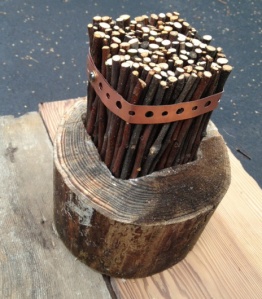
I know what you are thinking right now: “Gee, I think maybe I made a toppelduskin once, but I am not sure.” Or, perhaps, you are thinking about venturing into those uncharted waters yourself, but you are unsure of the criteria. And, you are afraid that you might make what you think is a toppelduskin, smugly present it to your slightly uptight and sometimes critical friend, and suddenly find yourself the subject of thinly disguised ridicule: “Oh. So that’s what you consider to be a toppelduskin? How…um…interesting!”
Well, let me help you avoid such an awkward situation. You can easily identify toppelduskins using my handy three-point check system:
1. You put two (or more) things together that normally do not go together.
2. You are not sure why you did it.
3. Someone asks you: “What is it?”
Actually, Step 3 is not so much a required step, but rather, a litmus test. After all, if someone looks at your creation and says that they have one like it at home, then it is hardly unique, and therefore unlikely to be worthy of the title of toppelduskin. To be fair, there is the remote possibility that your friend makes toppelduskins too. In which case, he may very well have one like it at home.
Actually, that raises another important question: What do you call someone who makes a toppelduskin? At first I thought it might a “toppeler” or a “dusker”, but I realized those names fall far short of the founder’s free-flowing, phonetical finesse.
One who makes toppelduskins is a skarbenfripper.
There is one last point to address: The temptation to succumb to the siren call of the flaccid, familiar comfort of utilitarianism. It will strike you at the very moment when victory is in your grasp. You will have just applied the Step 3 litmus test by subjecting your creation for review. And your judge will ask you, “what on earth you have done this time?” And you will think: “that is exactly what I was hoping to hear, but now I feel foolish”. And then you will feel the blood rushing to your face. And you will feel the need to justify your existence. And you will be tempted to say something stupid like, “It’s a candle holder” or “It’s an iPod holder” or some other common thing like that. And then your friend will say, “Oh…yeah…cool” as the light slowly dawns in her dim eyes and she inwardly congratulates herself for her keen ability to understand her quirky, artistic friend’s peculiar vision. And you—you poor fool—you will have that abominable mix of emotions that can only come by fighting your way to the top of the cheerleading squad, and then willingly surrendering your glorious position just to taste the hollow and fleeting acceptance of the prom queen. How sad.
Don’t do it. Be strong. Be courageous. Be free. Be a skarbenfripper. Make toppelduskins joyfully and shamelessly.
If you do make your own toppelduskin, please share it with me and the rest of the world.
In my dream world, toppelduskin will some day make it into Webster’s dictionary. Skarbenfripper would be a nice bonus.
Also, I hope you were impressed by my correct and non-offensive use of the word “faggot”.
Score 3 extra Beatles points if you wondered where Vera was.

A more transient form of the discipline: TableToppelduskin. I was greeted one morning by this fine example which one of my studio mates had left. It had the added benefit of dual purpose in that it also informed me that paper supplies had been restocked.



















